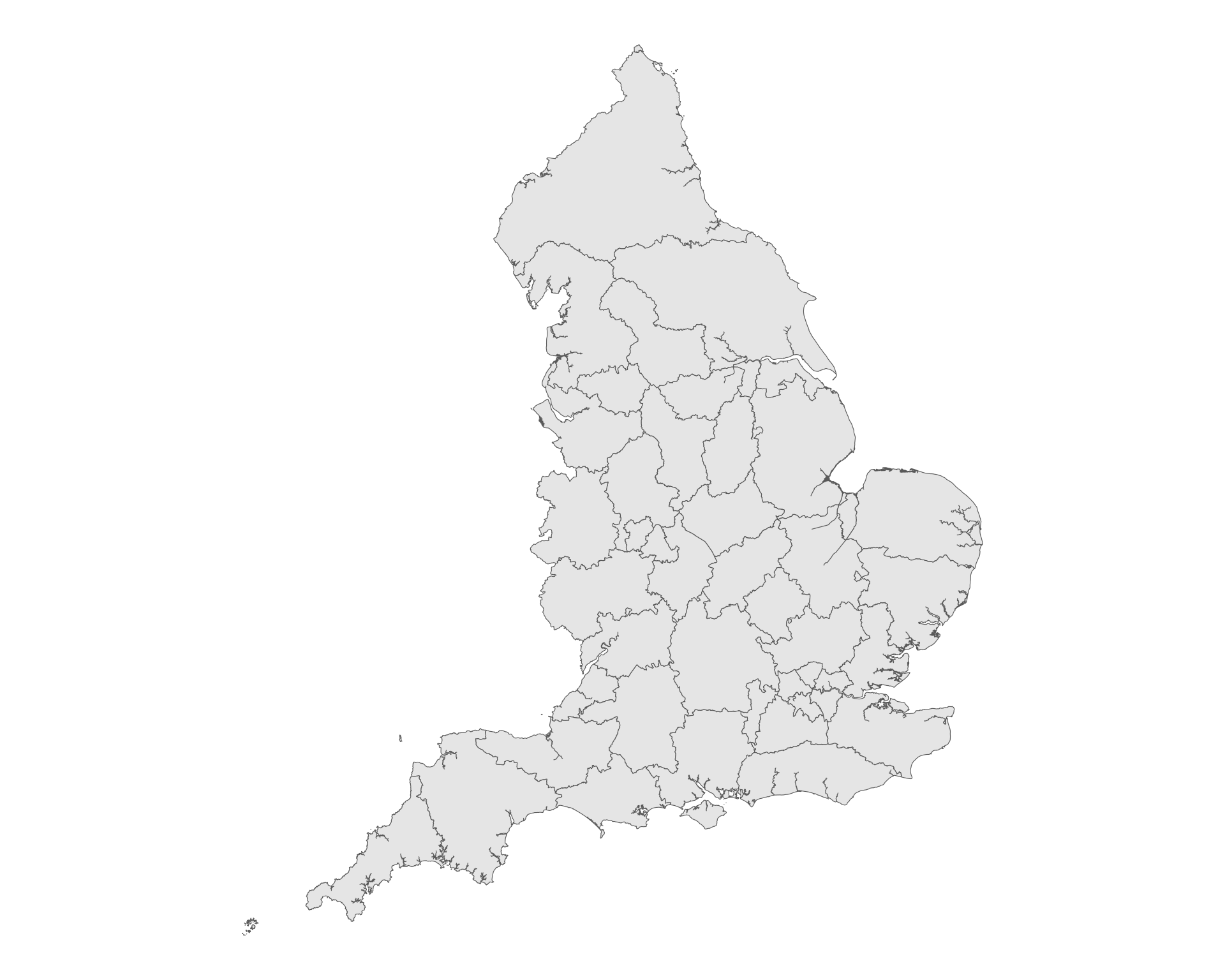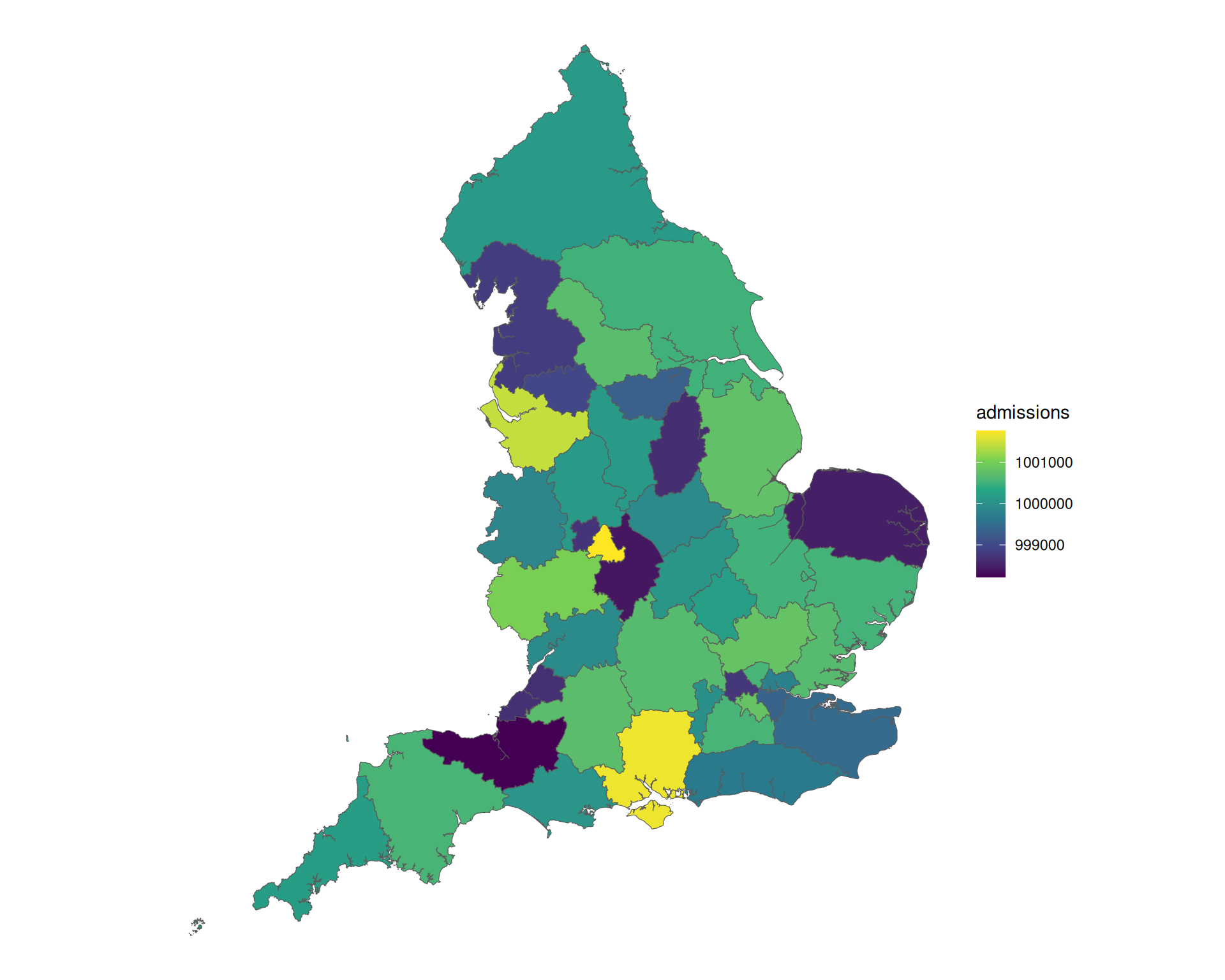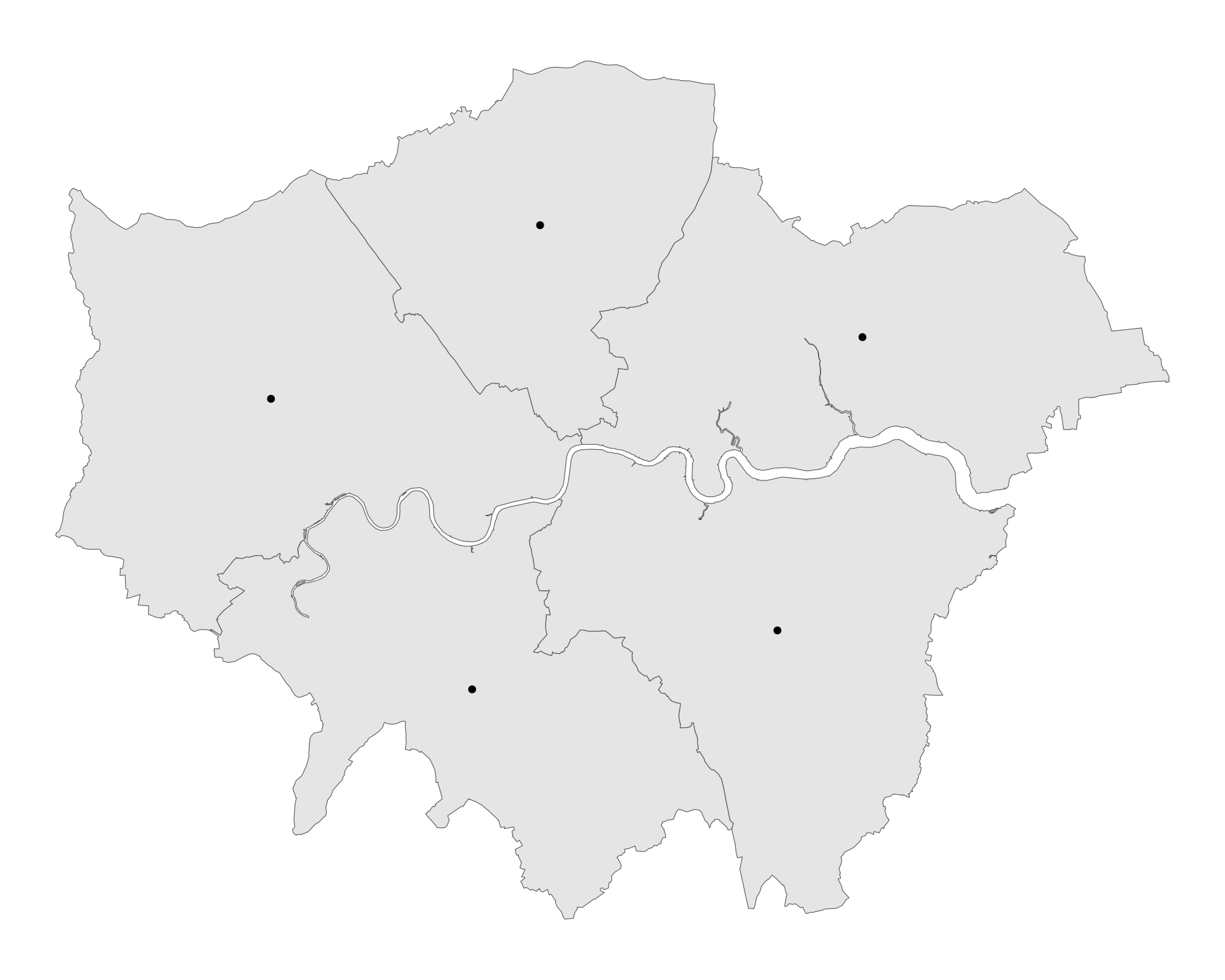Coffee and Coding
Working with Geospatial Data in R
Aug 24, 2023
Packages we are using today
Getting boundary data
We can use the ONS’s Geoportal we can grab boundary data to generate maps
What is the icb_boundaries data?
Simple feature collection with 42 features and 2 fields
Geometry type: MULTIPOLYGON
Dimension: XY
Bounding box: xmin: -6.418667 ymin: 49.86479 xmax: 1.763706 ymax: 55.81112
Geodetic CRS: WGS 84
# A tibble: 42 × 3
ICB23CD ICB23NM geometry
<chr> <chr> <MULTIPOLYGON [°]>
1 E54000008 NHS Cheshire and Merseyside Integrated C… (((-3.083264 53.2559, -3…
2 E54000010 NHS Staffordshire and Stoke-on-Trent Int… (((-1.950489 53.21188, -…
3 E54000011 NHS Shropshire, Telford and Wrekin Integ… (((-2.380794 52.99841, -…
4 E54000013 NHS Lincolnshire Integrated Care Board (((0.2687853 52.81584, 0…
5 E54000015 NHS Leicester, Leicestershire and Rutlan… (((-0.7875237 52.97762, …
6 E54000018 NHS Coventry and Warwickshire Integrated… (((-1.577608 52.67858, -…
7 E54000019 NHS Herefordshire and Worcestershire Int… (((-2.272042 52.43972, -…
8 E54000022 NHS Norfolk and Waveney Integrated Care … (((1.666741 52.31366, 1.…
9 E54000023 NHS Suffolk and North East Essex Integra… (((0.8997023 51.7732, 0.…
10 E54000024 NHS Bedfordshire, Luton and Milton Keyne… (((-0.4577115 52.32009, …
# ℹ 32 more rowsWorking with geospatial dataframes
We can simply join sf data frames and “regular” data frames together
Working with geospatial data frames
We can manipulate sf objects like other data frames
Working with geospatial data frames
Summarising the data will combine the geometries.
Simple feature collection with 1 feature and 2 fields
Geometry type: MULTIPOLYGON
Dimension: XY
Bounding box: xmin: -0.5102803 ymin: 51.28676 xmax: 0.3340241 ymax: 51.69188
Geodetic CRS: WGS 84
# A tibble: 1 × 3
area new_area geometry
* <dbl> [m^2] <MULTIPOLYGON [°]>
1 1573336388. 1567995610. (((-0.3314819 51.43935, -0.3306676 51.43889, -0.33118…
Why the difference in area?
We are using a simplified geometry, so calculating the area will be slightly inaccurate. The original area was calculated on the non-simplified geometries.
Creating our own geospatial data
Rows: 1
Columns: 40
$ postcode <chr> "B2 4BJ"
$ quality <int> 1
$ eastings <int> 406866
$ northings <int> 286775
$ country <chr> "England"
$ nhs_ha <chr> "West Midlands"
$ longitude <dbl> -1.90033
$ latitude <dbl> 52.47887
$ european_electoral_region <chr> "West Midlands"
$ primary_care_trust <chr> "Heart of Birmingham Teaching"
$ region <chr> "West Midlands"
$ lsoa <chr> "Birmingham 138A"
$ msoa <chr> "Birmingham 138"
$ incode <chr> "4BJ"
$ outcode <chr> "B2"
$ parliamentary_constituency <chr> "Birmingham Ladywood"
$ parliamentary_constituency_2024 <chr> "Birmingham Ladywood"
$ admin_district <chr> "Birmingham"
$ parish <chr> "Birmingham, unparished area"
$ admin_county <lgl> NA
$ date_of_introduction <chr> "198001"
$ admin_ward <chr> "Ladywood"
$ ced <lgl> NA
$ ccg <chr> "NHS Birmingham and Solihull"
$ nuts <chr> "Birmingham"
$ pfa <chr> "West Midlands"
$ admin_district_code <chr> "E08000025"
$ admin_county_code <chr> "E99999999"
$ admin_ward_code <chr> "E05011151"
$ parish_code <chr> "E43000250"
$ parliamentary_constituency_code <chr> "E14001096"
$ parliamentary_constituency_2024_code <chr> "E14001096"
$ ccg_code <chr> "E38000258"
$ ccg_id_code <chr> "15E"
$ ced_code <chr> "E99999999"
$ nuts_code <chr> "TLG31"
$ lsoa_code <chr> "E01033620"
$ msoa_code <chr> "E02006899"
$ lau2_code <chr> "E08000025"
$ pfa_code <chr> "E23000014"Simple feature collection with 1 feature and 2 fields
Geometry type: POINT
Dimension: XY
Bounding box: xmin: -1.900335 ymin: 52.47886 xmax: -1.900335 ymax: 52.47886
Geodetic CRS: WGS 84
postcode ccg geometry
1 B2 4BJ NHS Birmingham and Solihull POINT (-1.900335 52.47886)Creating a geospatial data frame for all NHS Trusts
What are the nearest trusts to our location?
Simple feature collection with 5 features and 4 fields
Geometry type: POINT
Dimension: XY
Bounding box: xmin: -1.9384 ymin: 52.4533 xmax: -1.886282 ymax: 52.48764
Geodetic CRS: WGS 84
# A tibble: 5 × 5
name org_id post_code geometry distance
<chr> <chr> <chr> <POINT [°]> [m]
1 BIRMINGHAM WOMEN'S AND CH… RQ3 B4 6NH (-1.894241 52.4849) 789.
2 BIRMINGHAM AND SOLIHULL M… RXT B1 3RB (-1.917663 52.48416) 1313.
3 BIRMINGHAM COMMUNITY HEAL… RYW B7 4BN (-1.886282 52.48754) 1356.
4 SANDWELL AND WEST BIRMING… RXK B18 7QH (-1.930203 52.48764) 2246.
5 UNIVERSITY HOSPITALS BIRM… RRK B15 2GW (-1.9384 52.4533) 3838.Let’s find driving routes to these trusts
Simple feature collection with 5 features and 8 fields
Geometry type: LINESTRING
Dimension: XY
Bounding box: xmin: -1.93846 ymin: 52.45316 xmax: -1.88527 ymax: 52.49279
Geodetic CRS: WGS 84
# A tibble: 5 × 9
name org_id post_code straight_line_distance src dst duration distance
<chr> <chr> <chr> [m] <chr> <chr> <dbl> <dbl>
1 BIRMING… RQ3 B4 6NH 789. 1 dst 5.81 3.09
2 BIRMING… RXT B1 3RB 1313. 1 dst 6.87 4.14
3 BIRMING… RYW B7 4BN 1356. 1 dst 7.63 4.29
4 SANDWEL… RXK B18 7QH 2246. 1 dst 8.81 4.95
5 UNIVERS… RRK B15 2GW 3838. 1 dst 10.6 4.85
# ℹ 1 more variable: geometry <LINESTRING [°]>Let’s show the routes
We can use {osrm} to calculate isochrones
iso <- osrmIsochrone(location, breaks = seq(0, 60, 15), res = 10)
isochrone_ids <- unique(iso$id)
pal <- colorFactor(
viridisLite::viridis(length(isochrone_ids)),
isochrone_ids
)
leaflet(location) |>
addProviderTiles("Stamen.TonerLite") |>
addMarkers() |>
addPolygons(
data = iso,
fillColor = ~ pal(id),
color = "#000000",
weight = 1
)What trusts are in the isochrones?
The summarise() function will “union” the geometry
What trusts are in the isochrones?
We can use this with a geo-filter to find the trusts in the isochrone
Simple feature collection with 31 features and 3 fields
Geometry type: POINT
Dimension: XY
Bounding box: xmin: -2.793386 ymin: 52.19205 xmax: -1.10302 ymax: 53.01015
Geodetic CRS: WGS 84
# A tibble: 31 × 4
name org_id post_code geometry
* <chr> <chr> <chr> <POINT [°]>
1 BIRMINGHAM AND SOLIHULL MENTAL HE… RXT B1 3RB (-1.917663 52.48416)
2 BIRMINGHAM COMMUNITY HEALTHCARE N… RYW B7 4BN (-1.886282 52.48754)
3 BIRMINGHAM WOMEN'S AND CHILDREN'S… RQ3 B4 6NH (-1.894241 52.4849)
4 BIRMINGHAM WOMEN'S NHS FOUNDATION… RLU B15 2TG (-1.942861 52.45325)
5 BURTON HOSPITALS NHS FOUNDATION T… RJF DE13 0RB (-1.656667 52.81774)
6 COVENTRY AND WARWICKSHIRE PARTNER… RYG CV6 6NY (-1.48692 52.45659)
7 DERBYSHIRE HEALTHCARE NHS FOUNDAT… RXM DE22 3LZ (-1.512896 52.91831)
8 DUDLEY INTEGRATED HEALTH AND CARE… RYK DY5 1RU (-2.11786 52.48176)
9 GEORGE ELIOT HOSPITAL NHS TRUST RLT CV10 7DJ (-1.47844 52.51258)
10 HEART OF ENGLAND NHS FOUNDATION T… RR1 B9 5ST (-1.828759 52.4781)
# ℹ 21 more rowsWhat trusts are in the isochrones?
Doing the same but within a radius
r <- 25000
trusts_in_radius <- trusts |>
st_filter(
location,
.predicate = st_is_within_distance,
dist = r
)
# transforming gives us a pretty smooth circle
radius <- location |>
st_transform(crs = 27700) |>
st_buffer(dist = r) |>
st_transform(crs = 4326)
leaflet(trusts_in_radius) |>
addProviderTiles("Stamen.TonerLite") |>
addMarkers() |>
addPolygons(
data = radius,
color = "#000000",
weight = 1
)Further reading
view slides at the-strategy-unit.github.io/data_science/presentations


